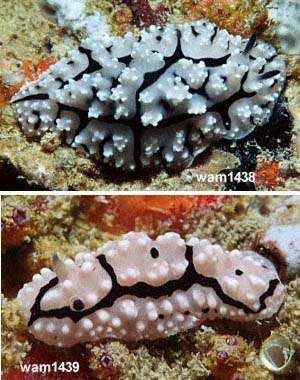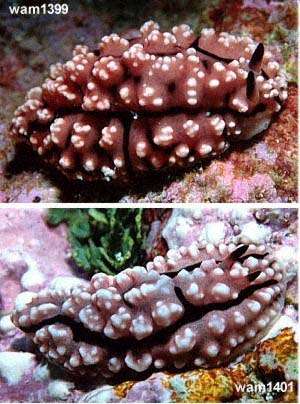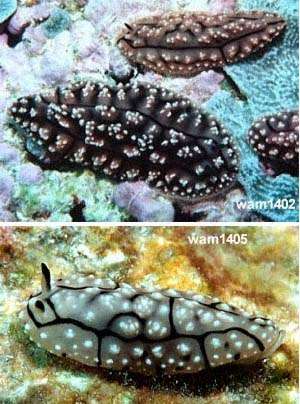Phyllidiopsis krempfi? from NW Australia
February 5, 1999
From: Clay Bryce

Hi Bill,
Hope your are keeping well. I am in the process of wading through the material from the last four trips. I have attached some images (at least I hope it works) of 6 phyllidiids that are giving me some trouble. Would you mind taking a look?
I have tham all down as P. cf. krempfi (complex)!!?? but I am not happy with the identifications. They are all from the Kimberley region of northwestern Australia.
Feel free to put them into the Forum.
WA1438: Cassini Island, North side. 13o56'S: 125o38'E. Depth 30 - 4.5m Drop-off to 30m. Shallows subject to high tidal current with stunted corals. Encrusting sponges in caves and underhangs of drop-off. Collected: 18/9/98 Length: 5.5cm
WA1439: Same data as 1438 Length: 2.5cm
WA1399: Hibernia Reef, North side: 11o58'S: 123o19E, Depth: 8 - 27m Slope, brocken coral rubble with scattered live coral and encrusting sponges. Collected: 11/9/98 Length: 4cm.
WA1401: Same data Length: 3.5cm
WA1402: Same data Length: Top: 3.5cm. Bottom: 5cm.
WA1405: Same data Length: 2.5cm
All the best,
Clay Bryce
Western Australian Museum
Perth.
brycec@museum.wa.gov.au


Clay,
I'm glad to see you have a scanning system at work! I've had a look at the images and am pretty sure they are all P.krempfi (sensu Brunckhorst). I make the following comments:
WA1402: I presume they are all the same. The large one looks a bit like Phyllidiopsis burni but the top specimen, at least, has pink and black rhinos. (P. burni has black rhinos) and the other possibility, Phyllidiopsis fissuratus has large long anal papilla which I can't see in your photos.
WA1439. The black tipped rhinos aren't right for P. krempfi but it is probably a
juvenile.? Possibly the black down the posterior edge doesn't appear until they're bigger.
Although David Brunckhorst's monograph is a great advance in our understanding of the family, I am sure he would be the first to acknowledge that we still have a lot to learn about the phyllidiids. One good way is to have a look at the variation. For that reason I am happy to put up more pictures of what is probably all one species.
Best wishes,
Bill Rudman.
Related messages
-
Phyllidiopsis krempfi from the Philippines
From: Mirjam Broos, November 26, 2009 -
Phyllidiopsis krempfi? from Malaysia
From: Kenneth Yong, September 8, 2006 -
Phyllidiopsis krempfi from Sth Africa
From: Charles Rowe, February 6, 2004 -
Phyllidiopsis krempfi from Mayotte
From: Marina Poddubetskaia, December 17, 2003 -
Phyllidiopsis krempfi from Solomon Ids
From: Scott Johnson, January 23, 2003 -
Phyllidiopsis krempfi from Indonesia
From: Ginette Allard, January 8, 2003 -
Phyllidiella rudmani? from Solomons
From: Bruce Potter, November 19, 2002 -
Phyllidiopsis krempfi from Indonesia
From: Olivia, October 2, 2002 -
Phyllidiopsis krempfi from Malaysia
From: Kheong Sann Chan, July 5, 2002 -
Phyllidiopsis krempfi from East Africa
From: Bernard Picton , May 23, 2002 -
Phyllidiopsis krempfi from Fiji
From: Mary Jane Adams, February 1, 2001 -
A mystery phyllidiid from Indonesia
From: Yasman, January 2, 2001 -
Phyllidiopsis krempfi from Indonesia
From: Yasman, January 1, 2001 -
Phyllidiopsis krempfi (?) from Indonesia
From: Yasman, January 1, 2001 -
Phyllidiopsis krempfi? from Philippines
From: Erwin Koehler, June 17, 2000 -
Phyllidiopsis krempfi from Thailand
From: Narongpon Sittithaweepat, April 19, 2000 -
Phyllidiopsis krempfi? from Sulawesi
From: Lindsay Warren, February 16, 2000 -
Phyllidiopsis krempfi from Japan
From: Yasuhiro Shirai, December 16, 1999 -
Phyllidiopsis from the Philippines
From: Erwin Koehler, December 12, 1998
